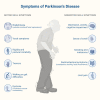Parkinson's disease updates: Addressing the pathophysiology, risk factors, genetics, diagnosis, along with the medical and surgical treatment
- PMID: 37811009
- PMCID: PMC10553032
- DOI: 10.1097/MS9.0000000000001142
Parkinson's disease updates: Addressing the pathophysiology, risk factors, genetics, diagnosis, along with the medical and surgical treatment
Abstract
After only Alzheimer's disease (AD), Parkinson's disease (PD) is the second most prevalent neurodegenerative disease. The incidence of this disease increases with age, especially for those above 70 years old. There are many risk factors that are well-established in the contribution to the development of PD, such as age, gender, ethnicity, rapid eye movement sleep disorder, high consumption of dairy products, traumatic brain injury, genetics, and pesticides/herbicides. Interestingly, smoking, consumption of caffeine, and physical activities are the protective factors of PD. A deficiency of dopamine in the substantia nigra of the brainstem is the main pathology. This, subsequently, alters the neurotransmitter, causing an imbalance between excitatory and inhibitory signals. In addition, genetics is also involved in the pathogenesis of the disease. As a result, patients exhibit characteristic motor symptoms such as tremors, stiffness, bradykinesia, and postural instability, along with non-motor symptoms, including dementia, urinary incontinence, sleeping disturbances, and orthostatic hypotension. PD may resemble other diseases; therefore, it is important to pay attention to the diagnosis criteria. Parkinson's disease dementia can share common features with AD; this can include behavioral as well as psychiatric symptoms, in addition to the pathology being protein aggregate accumulation in the brain. For PD management, the administration of pharmacological treatment depends on the motor symptoms experienced by the patients. Non-pharmacological treatment plays a role as adjuvant therapy, while surgical management is indicated in chronic cases. This paper aims to review the etiology, risk factors, protective factors, pathophysiology, signs and symptoms, associated conditions, and management of PD.
Keywords: Parkinson’s disease; diagnosis; genetics; orthostatic hypotension; pathophysiology; treatment.
Copyright © 2023 The Author(s). Published by Wolters Kluwer Health, Inc.
Conflict of interest statement
The authors declare that they have no conflicts of interest.Sponsorships or competing interests that may be relevant to content are disclosed at the end of this article.
Figures


References
-
- Dorsey ER, Constantinescu R, Thompson JP, et al. . Projected number of people with Parkinson disease in the most populous nations, 2005 through 2030. Neurology 2007;68:384–386. - PubMed
-
- Alzheimer’s Association. 2014 Alzheimer’s disease facts and figures. Alzheimers Dement 2014;10:e47–e92. - PubMed
-
- Kalia LV, Lang AE. Parkinson’s disease. Lancet Lond Engl 2015;386:896–912. - PubMed
-
- Kouli A, Torsney KM, Kuan W-L.Stoker TB, Greenland JC. Parkinson’s disease: etiology, neuropathology, and pathogenesis. Parkinson’s Disease: Pathogenesis and Clinical Aspects. Codon Publications; 2018. - PubMed
Publication types
LinkOut - more resources
Full Text Sources
Medical
Research Materials
